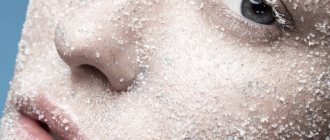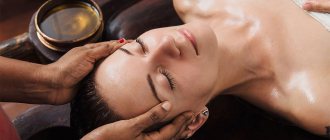We love winter for its festive atmosphere, cozy gatherings at home, beautiful snowy landscapes and fun outdoor games. When the temperature outside is below zero, we diligently insulate ourselves, put on warm sweaters, protect our heads with a hat, our hands with mittens, and take out a warmer coat. But how to protect your face?
After all, in winter, the skin suffers from frost and wind, constant temperature changes, it flakes, becomes inflamed and dehydrated, and becomes dull.
What should proper facial care look like in winter, what products should you pay attention to, how to choose them for different skin types and always remain beautiful? In this article I will answer all questions and share professional secrets.
Normal skin
This type does not suffer from excessive sebum production or lack of moisture. However, even normal skin needs to be taken care of in winter to maintain a stable condition and prevent overdrying.
For normal skin of the face and body, a cream with a light texture is suitable; a denser one may provoke additional sebum production. It is better to use a product that absorbs quickly and is suitable as a base for makeup. Before using the cream, do not forget to cleanse your skin - morning and evening - and wash your face with cool water.
Dry skin
The dry type is highly sensitive at any time of the year, but it reacts especially negatively to frost and wind. Temperature changes and dry air lead to irritation and peeling.
Skin care in winter involves the use of a cream with healing elements (for example, aloe vera gel) and moisturizing components: ceramides, glycerin. Ceramed creams have the necessary formulation with these elements, which above all allows you to restore dry skin
Dry skin cannot be aggressively cleansed with scrubs or peels: they destroy the lipid layer that retains moisture. Even sudden movements with a towel can negatively affect the condition of the skin.
Take care of hydration
As at other times of the year, basic facial care in winter is based on hydration. Transepidermal fluid loss occurs faster in cold weather. Air dried out by batteries only worsens the picture.
To make your skin feel good, it can be helped by replenishing it with moisture from the outside. The active components of caring creams will help with this: hyaluronic acid, aloe, glycerin. Simply “attracting” water molecules is not enough - it must be retained in the structure of the epidermis. Shea, macadamia, camellia, and wheat germ oils compensate for the lack of natural lipids and form a barely noticeable protective layer on the skin.
Age-related processes cannot be paused. After 25, the skin produces less and less natural hyaluronic acid, collagen and elastin every year. Metabolic processes in cells slow down. To maintain youth longer, the skin requires intense hydration and additional vitamin support. After 40 years, facial care in winter must necessarily include active ingredients that stimulate the synthesis of “framework” proteins.
Oily skin
Those with an oily skin type have the easiest time surviving the winter: sebum is secreted in large volumes, so the lipid layer continues to protect the skin from moisture loss, even despite severe dryness. Is skin care really not so necessary in winter?
It is important to maintain a stable skin condition so as not to deprive it of these benefits and at the same time eliminate oily shine. A moisturizer will help with this: the fact is that sebum is released precisely because of a lack of moisture - as compensation.
Ceramed creams are well suited for caring for this type of skin, because all skin needs hydration. You need to do this wisely in combination with specialized products for the care of oily skin.
SPF in winter. Why is it important!
The opinion that ultraviolet radiation is dangerous for the skin only in warm seasons is a misconception. In winter, the skin is susceptible to the harmful effects of UV rays, even in cloudy weather. UVA radiation (a type of ultraviolet rays active in winter) is one of the main causes of dry skin, wrinkles and hyperpigmentation.
In order for SPF products to effectively protect the skin, it is necessary to follow their application technique. First, daytime care products are applied, then after 15–20 minutes, cream with SPF is applied.
Combination skin
The combination type is characterized by high oil content in the T-zone and dryness on the cheeks. Winter care for combination skin of the face and body is similar to caring for normal skin. If the condition of the T-zone and cheeks is not too different, use universal creams that moisturize and protect. If certain areas of the skin are problematic, apply the cream specifically to this part.
You need to take care of your skin not only with skincare products. Nutrition, vitamins and lifestyle play an important role. A balanced diet is closely related to the condition of the skin - regardless of its type.
Charge yourself with vitamins
Fresh fruits and vegetables are rather rare in winter. A lack of vitamins and minerals immediately affects the skin: it becomes dull, acquires an uneven texture, and recovers more slowly.
Sea buckthorn and rose hips give a powerful boost of vitamins. A cup of berry tea is a great way to warm up after a winter walk, while your face is taken care of by the “Clean Line” nourishing cream with the same “delicious” composition. Sea buckthorn oil and rosehip extract saturate cells with beneficial substances, stimulate metabolic processes, make the skin elastic and help smooth out fine wrinkles. Due to its rich vitamin and mineral composition, sea buckthorn is a classic component of anti-aging creams. Rosehip is a real storehouse of vitamin C. As part of the cream, it helps preserve the beauty and youth of the skin: it works as an antioxidant, stimulates collagen synthesis, and regulates cell renewal.
Eat properly
A healthy diet dramatically affects the condition of the skin. In winter, most often you want to treat yourself to unhealthy food in order to quickly warm up and cheer up, despite the lack of sun. However, fatty foods and sweets in large quantities, fast food and soda lead to rashes, irritation, and dryness.
Your diet should contain omega-3 fatty acids, which help protect your skin from external damage. To do this, you need to eat more fatty fish or replace it with fish oil. Also don't forget about nuts, avocados, spinach and oils.
In addition, eat foods that accelerate regeneration processes: bright vegetables and berries are rich in antioxidants. Cranberries, black currants, raspberries, peppers, beets - be sure to include them in your menu.
Meals should be varied and include more fluids
Our diet and drinking regime are especially important for the skin in winter, when the body lacks vitamins and moisture reserves quickly decrease. As a result, the skin becomes dry and lifeless, but this can be corrected. To do this, you need to eat fruits, vegetables, juices, lactic acid products, greens, cereals and grains, and fish. You should drink enough liquid, it can be raw water, green tea, cranberry or lingonberry juice, or rosehip decoction. All this will not only reduce skin problems, but also help the immune system fight viral infections and colds.
Wash your face correctly
The first rule of skin care in winter is to wash your face properly:
- For cleansing, choose gentle products, without alcohol and sulfates.
- do not wash your face with hot water - this will dry out your skin (ideally, wash your face with cool, clean water from a filter)
- Do not wipe your face aggressively, but pat it dry with a towel.
Avoid scrubs, peelings and hot showers
In winter, the skin is most sensitive to chemicals and friction. Therefore, scrubs and peels especially irritate the skin, disrupting the integrity of the lipid barrier. When caring, it is better to focus on nutrition and hydration.
The same goes for hot showers: it destroys the epidermal layer, damaging the fatty acids that retain moisture. Therefore, the shower should last about five minutes (longer is permissible only at average water temperature). And be sure to use a nourishing cream after water procedures.
Features of winter facial care
You can change the washbasin to a softer one
Often in winter it is enough to replace only the day cream with a richer one, and the rest of the products - cleanser, toner, night cream - can be left the same if the skin feels comfortable.
But if you experience dryness and tightness of your skin after washing, then in this case in winter it makes sense to change your regular face wash to a softer one.
For example, if you have combination skin, and in the summer you used a cleansing gel for oily and combination skin, and in the winter, areas of red, dry and flaky skin often appear on your face, you may well take a cream gel or foam cleanser for sensitive skin for the winter .
Layered makeup
If you wear makeup, this will serve as additional protection for your skin in winter. But if in summer you can simply apply moisturizer or BB cream to the skin, then winter makeup should be layered.
First you need to apply the day cream, let it absorb, then apply the foundation, and then you can also set it all with a small amount of loose powder.
Additional care
In winter, you can actively use additional home care products - masks and serums.
Nourishing and moisturizing masks can be done a little more often in winter - 2-3 times a week. And serums should be used as usual - in short courses.
When it comes to salon treatments, fall and winter are a great time for chemical peels and massages.
And although massage can be done all year round, in winter massage is especially important because it improves blood circulation and, consequently, skin nutrition.
Choose the right cream
What is the best way to take care of your skin in winter? Look for creams with ceramides in their composition. This is a key element of the stratum corneum, which connects epidermal cells and holds water molecules on the surface of the skin. In addition, ceramides fight damage to cell structure.
Also look for other moisturizing ingredients: urea, glycerin, propylene glycol. They retain moisture on the surface of the skin and make it more elastic and radiant. Try to purchase skincare cosmetics for different parts of the body, because depending on this they have different properties.
- Ultra-moisturizing Cera cream for face and body restores the protective layer of the skin, soothes and relieves discomfort, and is suitable as a base for makeup.
- Ultra-moisturizing hand cream is suitable for sensitive, very dry and irritation-prone skin. It relieves irritation, is quickly absorbed and does not leave a sticky film.
- Ultra-moisturizing cera cream saves the skin of the feet from dryness, eliminates cracks and calluses, moisturizes and softens.
Exfoliate excess
During the cold season, metabolic processes slow down. The skin does not renew itself as quickly as we would like - dead scales of the stratum corneum linger on the surface of the face, its relief becomes less even. This is often accompanied by pimples: sebum cannot escape, creating a favorable environment for the growth of bacteria.
Regular exfoliation will help get rid of dead cells and signs of chapping. In order not to injure the hydrolipidic mantle of the skin, it is advisable to replace highly abrasive scrubs with scrub-masks with delicate exfoliating particles or peelings with AHA acids.
Take care of your lip skin
Also in winter you need to protect areas where there are no sebaceous glands, in particular the lips. Ultra-moisturizing cera lip balm with vitamin E nourishes delicate skin, protecting it in any weather. It prevents the appearance of cracks, promotes regeneration and is suitable as a base for lip makeup.
In winter, try not to use matte long-lasting lipsticks - they dry out the skin. If you decide to wear this lipstick, moisturize your lips with a protective balm. In addition, do not forget to use the balm before going to bed and try not to lick your lips in the cold.
The use of Clindovit® gel in the fight against acne
Exposure to cold, wind, and temperature changes can negatively affect the appearance of the skin. If acne worsens in winter, it is necessary to take a responsible approach to its treatment. Anti-acne therapy requires regularity; you cannot interrupt it yourself, otherwise there may not be any effect.
When treating mild to moderate acne, you can use Clindovit® gel6, 18. This is a topical antibiotic that has an antimicrobial effect on propionibacteria 6. Also, when Clindovit® gel is applied to the skin, the level of free fatty acids decreases from approximately 14 to 2% 6.











